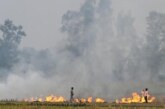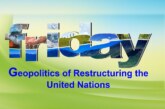
Dr. Arvind Kumar*

The world is facing increasingly complex climate-related challenges that are reducing our resilience to climate shocks and increasing our vulnerability to natural hazards. The frequency and intensity of climate-related hazards such as cyclones, flooding, and drought are rising, affecting millions of people each year. Loss of lives, livelihoods, huge infrastructural losses which comes out to be in millions due to natural disasters in hilly states of India has become a recurring pattern which sadly the government is unable to interpret like in Himachal couple of months back. Unsustainable development, rapid urbanization, bursting population are exacerbating factors. The Sikkim disaster appears to be a repeat of events like the one that happened at Kedarnath in 2013 and Chamoli in 2021 – a sequence of events that marks the increasing risk caused by the upward trend in global warming and sustained melting of mountain glaciers. Combined with unregulated constructions, hydroelectric projects and anthropogenic activities, these events evolve into massive disasters.
As per a recent study high-mountain Asia, home to the Himalayas, ranked the most dangerous, with 9 million people exposed to 2,211 lakes. Pakistan and China had the highest risk globally, with nearly 2 million and 1 million people exposed, respectively. The Geological Survey of India reports about 9,575 glaciers in the Indian part of the Himalayas. The annual rate of retreat of glaciers in this part ranges between 5 and 20 m per year. Based on satellite-based observations, it is estimated that the Himalayas lost 13% of the glacier area between 1960 and 2000.The studies also indicate that the average temperature in the Himalayas has risen by 0.66° C since 1991 – an increase much higher than the global average. The higher Himalayas became even warmer on average in the same period. The winters in the Himalayas have been getting warmer and wetter over the last 25 years. The unprecedented extreme rainfall events as seen in Himachal Pradesh during this year’s monsoon season are attributable to climate shifts.
Rightly said by Himanshu Thakkar of SANDRP that authorities failed to apply the lessons from a 2021 dam breach in the Himalayan state of Uttarakhand that killed 81 people, allowing an “eerily similar” disaster to occur. Despite being the biggest project in the state, there were no early-warning systems installed even though the glacier overflowing was a known risk.
India passed a dam safety law in 2021, but the Teesta 3 dam is not listed as being monitored for safety by India’s chief dam regulator, the Central Water Commission. Why?
A decade has passed since the Kedarnath disaster, and yet another devastating experience of glacial outburst in another part of the Himalayas – not much progress was made on predictive capabilities. Why didn’t the authorities do much on this front despite ample warnings on the GLOF potential of the glacial lakes in Sikkim given out by the researchers?
Development but at what cost?
The Sikkim disaster shows that repeated warnings from the individual research groups that have been communicated through scientific reports and papers in the past were ignored and the contingency plans were put on the back burner. The written replies from the national agencies on potentially dangerous glacial lakes that were published in the 23rd report of March 2023, submitted by the Parliamentary Committee, do not mention the potentially hazardous ones located in the Sikkim Himalaya. Why was a highly expensive hydroelectric project costing about Rs 14,000 crore, commissioned only in 2017, which was breached and severely damaged in the flood, not taking the flood projections into account? Who is accountable for the under-engineered structure? The Union and state governments are building up dams in the Himalayan states to tap the hydroelectric power. The Teesta dam mishap is yet another warning to reconsider the efficacy and sustainability of such projects constructed within the dynamic environmental settings of the Himalayas. Construction of such a big hydel power plant at a high altitude in Sikkim’s fragile ecosystem was a human-made mistake. The floods would not have caused such huge damage had it not been for the hydel power project.

The riverside wetlands help mitigate local flooding because they also act as storage spaces but with construction and encroachment of these banks, we invite more danger and disaster. As member of the National wetlands Committee of the Ministry of Environment forests and climate change while drafting the guidelines for the Wetlands Conservation and Management Rules, 2017 we linked the wetlands to revenue records which further lead to more wetlands cropping up through GIS mapping and more by removing encroachments. The guidelines clarified that all wetlands, irrespective of their location, size, ownership can be notified under the Wetlands Rules 2017.Similarly, Ecosystem-based Disaster Risk Reduction (Eco-DRR) should be integrated into national and local development programmes and strategies.
The eastern Himalayas require special attention in terms of the potential for earthquakes as well as flood disasters. A special effort needs to be mounted to develop hazard scenarios and models as well as land zonation maps that demarcate areas prone to floods and landslides. There should also be a serious rethinking of the developmental models for the Himalayan states in the context of climate change and the earthquake potential, while also bringing the major stakeholders – the people – on board for their feedback. The previously mentioned Parliamentary Committee in their report on Glacier Management in the Country while discussing the glacial lake outbursts, conveniently chose to be silent on the massive infrastructure projects like roads and dams being implemented in the Himalayan terrain on a war footing that compound the effects of glacial floods and avalanches.
There is severe shortage of meteorological and monitoring stations in Himalayan regions. The current predictive capabilities of natural disasters remain underutilised in India. The Doppler Weather Radar networks capable of detecting extreme weather conditions need to be used more widely through an integrated national disaster communication network and informatics system. India needs an online disaster information network that will use archival data on past events in conjunction with current data. Field sensors for recording water level changes in glacial lakes that are identified to be hazardous should have been deployed and facilities for transmitting the data through satellites in place. There are 39 glacial lakes and water bodies across India, China and Nepal that have recorded more than 40% increase in the water spread area since 2009. They pose a great threat to the Indian hilly states and union territories and need to be monitored closely.
Way Forward
The key is integrated approach. SDGs can only be effectively implemented and achieved if they are localised and integrated in to our policies. Engaging stakeholders at all levels to facilitate integration of conservation and restoration into livelihood strategies. There needs to be a paradigm shift in understanding the perception of water as an integral part of ecosystem, a natural resource and socio-economic indicator. Adaptation needs to be there against risks emanating from water-induced and environment-induced vagaries in terms of insecurity of water, food and energy sectors, floods, drought, water and air pollution, erosion of land, loss of biodiversity, deforestation and loss of livelihoods. There should be enhanced cooperation between upper and lower riparian countries in sharing early warnings, flood information and vulnerability assessments etc. where platforms like SANS of the UNESCAP can come in handy.
The state now faces the challenging task of not only rehabilitating the affected people and providing shelters, but to make this an opportunity to build better infrastructure and move towards being disaster resilient. This can be done by taking appropriate measures to ensure prevention, mitigation, and preparedness. All others, be it the central government, the NGOs, and other organisations should give the required support to make it possible. Keeping in these urgencies a regional Water Hub should be established, which will serve as a platform for early warning system, sharing of data/ information, technological advancements, knowledge, best practices/ success stories in the water sector could be networked and disseminated keeping in view the regional requirements. None of these options will work on their own, and what is appropriate and works in one location may not work in another. It’s really now about looking at the local level and finding the appropriate measures for the threatened populations.
*Editor, Focus Global Reporter



